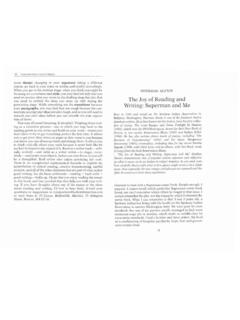Transcription of Language and Culture - EOLSS
1 UNESCO EOLSSSAMPLE CHAPTERSLINGUISTIC ANTHROPOLOGY - Language and Culture - Elizabeth Keating Encyclopedia of Life Support Systems ( EOLSS ) Language AND Culture Elizabeth Keating Anthropology, University of Texas at Austin, USA Keywords: Language , Culture , meaning, social interaction, Language ideologies, Language policies, Language and thought, power and Language , Language and status, Language and technology Contents 1. Introduction 2. Cultural Definitions of Language 3. The study of Language and Culture 4. Learning Culture and Language 5.
2 Language and Cultural Patterns of Thought 6. Cultural Institutions and Language 7. Language , Power, Difference 8. Language and Technology 9. Conclusion Glossary Bibliography Biographical Sketch Summary Through Language we create and share with others our ways of doing things and ways of being in the world, our Culture . Language is a tremendous tool for the organization of particular realities, including a wide variety of social relationships and social systems. Through Language we are continually socialized, we build or resist authority, we worship, argue, and imagine.
3 We name and give meaning to aspects of experience from particular perspectives. For example, members of different cultures can have quite different and local notions of self and strategies of interpretation, including who are authorized speakers and hearers. Language and Culture are linked in the transmission of knowledge, in the construction of social life, and ideologies about Language use and its relation to human behavior. 1. Introduction Language plays a vital role in establishing and maintaining what we call Culture , including conventions, habits and interpretive practices of individuals and communities.
4 Through Language we create and share with others identities, categories, attitudes, values and belief structures. The study of how a particular Culture uses Language can reveal important aspects of sociality and behavior, including how people organize activities, socialize new members, build or resist authority, use literacy tools, worship, argue, and imagine. Language is not only a rule-governed system with its own internal rules and logic (learned by every child in the community), but a system of tools for the constitution of social life and Culture .
5 For anyone acquiring a new Language and UNESCO EOLSSSAMPLE CHAPTERSLINGUISTIC ANTHROPOLOGY - Language and Culture - Elizabeth Keating Encyclopedia of Life Support Systems ( EOLSS ) approaching a different Culture , one of the first seemingly simple lessons to be learned are greetings. However, there are complex skills required in properly using greetings, when to say them, to whom to say them, and in what manner, since greetings do complex social work, and they reflect and construct complex, multi-faceted relationships.
6 Openings and closings of encounters are rich sites for studying the establishment of social relations and other social work in the construction of society, and how these communicative events vary in their structure and meaning across cultures. Each Culture classifies not only its activities but also its surroundings into categories such as public and private, teaching or learning environments, burial sites, formal and informal, and so forth. Members of communities learn to interpret these frames and what kinds of audiences and Language will be appropriate in each frame and how their possible identities will be relevant.
7 New challenges and contexts have arisen recently through new technologies which can transgress customary frames, for example, with television bringing scenes of places and people, both real and fictional, into the home and with the capability of searching the Internet for many types of knowledge and expertise, and reaching audiences, both intended and unintended, outside the immediate environment. Language does not simply represent a situation or object which is already there; it makes possible the existence or the appearance of the situation or object, because it a crucial device for the creation of situations and objects.
8 Speakers use Language to create reality by naming and giving meaning to aspects of experience from a particular perspective, thus Language has a normalizing and regulative function, as individuals take up particular positions and stances and produce themselves through Language . This is a complex process requiring constant work and negotiation. The close analysis of Language in particular cultural contexts shows how these meanings are socially and culturally produced, for example, speakers can have quite different and local notions of self and strategies of interpretation.
9 Cultures differ in their ideas about who are authorized speakers and hearers (or, since signed languages are not based on auditory channels, Language producers and Language receivers ) and about the ability to control interpretation and responsibility for interpretation, for example, the relevance of sincerity and intentionality. As Alessandro Duranti has shown, intentionality and responsibility for meaning can be construed quite differently in different cultures. Through the use of linguistic and other communicative resources, culturally relevant meanings emerge and are negotiated through messages that are actively responded to.
10 Meaning is a moment-by-moment achievement which links past and present and forms a context for the future. Through Language , cultures create particular realities, including a wide variety of social relationships and social systems. Language and Culture are linked, for example, in the following areas: in terms of expressing categories such as gender, in marking off certain encounters and contexts as formal such as cultural institutions, the transmission of knowledge, the acquisition of Language , multilingualism, identity, ideologies about Language use and its relation to human behavior, literacy, Language change, the social valuing of particular Language and social practices, the use of technologies, and the aesthetics of Language production and social comportment in communicating with others.










